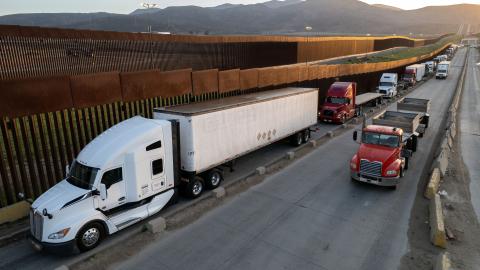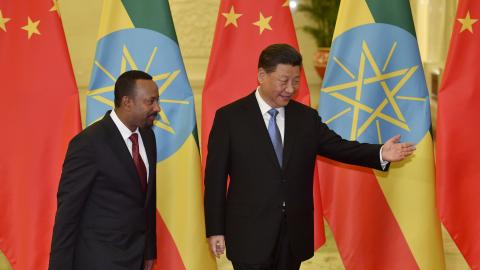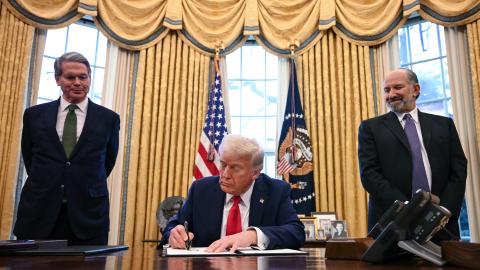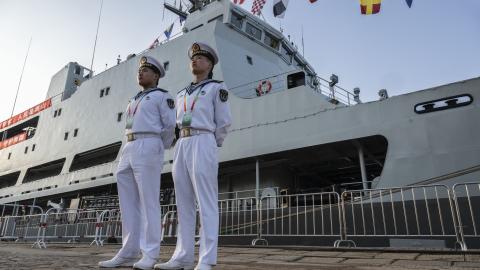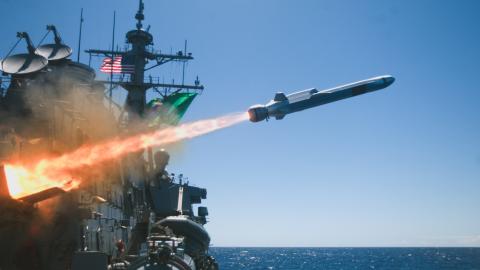Executive Summary
President Donald Trump has made ending the war in Ukraine a central pillar of his foreign policy. While his desire to broker peace appears sincere, any resolution needs to preserve Ukrainian sovereignty and the long-term security interests of the United States and its allies. A ceasefire that allows Russia to regroup and rearm would only delay a larger conflict. The war’s outcome will shape Ukraine’s future as well as the future of transatlantic security.
Since Russia’s full-scale invasion in 2022, Ukrainians have demonstrated remarkable resilience and courage, reclaiming nearly half of the land Russia initially occupied. The Ukrainians want the war to end, but they do not want to surrender. Instead, they seek a just peace, which should be rooted in four essential principles:
- Formal non-recognition of Russian-occupied Ukrainian territory. Occupied areas should never be legitimized as part of the Russian Federation. The 1940 Welles Declaration, wherein the US refused to recognize Soviet control of the Baltic states, is a useful precedent for how such a policy can uphold international law.
- Meaningful reconstruction assistance. Western governments and institutions should help fund Ukraine’s recovery with a combination of frozen Russian assets, private investment, and direct aid, ensuring the country’s economic resilience and long-term stability. Major ports such as Mykolaiv and Kherson should be reopened.
- Return of prisoners of war, political detainees, and abducted Ukrainian children. Tens of thousands remain in Russian custody, including over 19,000 children forcibly taken from their families. Repatriation should be a moral and legal priority in any settlement.
- Full preservation of Ukrainian sovereignty. Ukraine needs the right to shape its own government, conduct elections, join alliances, and build its military free from Russian interference.
While the Biden administration provided important early support, its long-term approach focused on managing escalation rather than enabling Ukrainian victory. President Trump, by contrast, has made ending the war the primary goal. But peace can only be achieved with lasting security guarantees. Because North Atlantic Treaty Organization membership is not likely under the current administration, Ukraine and its partners should pursue a five-layered strategy to secure a just and durable peace while deterring future Russian aggression.
- Layer 1: A civilian-led monitoring mission. A neutral actor that both sides can trust should verify compliance with ceasefire terms and patrol the line of occupation.
- Layer 2: A coalition of the willing. Countries like the United Kingdom, France, Canada, and Türkiye can contribute to a rotational ground force presence, an air policing mission, and regular naval patrols in the Black Sea.
- Layer 3: American support. Though the US is unlikely to deploy troops on Ukrainian soil, Washington should provide over-the-horizon capabilities, revive the National Guard partnership program, expand defense industrial cooperation with Kyiv, finalize a critical minerals agreement, and continue supplying military aid.
- Layer 4: Euro-Atlantic engagement. Ukraine and its allies need to invest in a NATO-Ukraine Center of Excellence, allow Ukraine to participate in the NATO Response Force, create a joint European Union training mission, and reform EU regulations to accommodate future Ukrainian membership.
- Layer 5: Reinforce NATO’s eastern flank. These measures should include sustained deployments, deeper integration of Poland into NATO’s nuclear framework, a new northern Europe air defense mission, and a continued US troop presence in Europe.
The US needs to shape a just peace—not settle for a false peace that gives Russia the upper hand. At the time of writing, there is no indication that Russia will negotiate in good faith. After a few rounds of talks between US and Russian officials, including a phone call between Presidents Donald Trump and Vladimir Putin, progress seems to have stalled. However, if the US can successfully lead talks between Ukraine and Russia, this policy memo lays out a path to a just peace and a secure Ukraine in the long term while accounting for current political constraints and geopolitical realities.
Introduction
President Trump has made resolving Russia’s invasion of Ukraine one of the cornerstones of his foreign policy. There is no doubt that he is sincere in his desire to bring the fighting to an end. But a short-lived ceasefire that gives Russia time to refit, rebuild, and reconstitute its armed forces would not serve American interests and could lead to a larger conflict.
Recent developments have only reinforced the fact that Moscow remains the principal obstacle to a just and lasting peace. As the saying goes, if Russia stops fighting, the war ends; if Ukraine stops fighting, Ukraine ends.
Many US policymakers would prefer to give Ukraine the weapons and resources it needs to achieve success on the battlefield. But President Joe Biden never fully embraced this strategy. While there is no question that US support in the early stages of the war helped Ukraine survive the initial Russian assault, the Biden administration sought to provide just enough support to signal US involvement—though not enough to allow Ukraine to win decisively.
While President Trump has made ending the war itself the central focus of his Ukraine policy, he seems similarly unlikely to provide Ukraine decisive military support. Therefore, a negotiated resolution will likely shape not only Ukraine’s future, but also the long-term security of the transatlantic region.
This paper offers a rough outline of a lasting and just peace for Ukraine.
Ukraine’s Goals
- A just peace. Russia is the aggressor; Ukraine is the victim. Against overwhelming odds, the Ukrainian people have resisted Russia’s full-scale invasion. Since February 2022, Ukraine has managed to liberate nearly half of the territory Russia initially seized. Ukraine is not seeking unconditional Russian surrender. But the Ukrainian people need a fair and just peace.
- Long-term security. It is reasonable for Ukraine to demand long-term security guarantees after facing repeated acts of Russian aggression. The West has promised Kyiv security in the past—only to break those assurances when the rubber met the road.1 The US needs to back any future peace with credible and enforceable security guarantees, not vague political commitments. With Washington reluctant to play a direct role, Europe has no choice but to step up.
- Future NATO and EU membership. Ukraine is a powerful reminder that sovereign nations need the right to choose how they are governed and which international organizations they join. Since 2014, Ukrainians have made their aspirations clear—through public demonstrations, democratic elections, and ultimately, through their sacrifice on the battlefield: they see their future within the Euro-Atlantic community. Therefore, eventual NATO and EU membership should be a medium-term objective for Ukraine—even if US and European leaders are not yet prepared to say so publicly.
Planning Assumptions
As US and European policymakers work toward a lasting settlement to Russia’s invasion of Ukraine, they should consider the following assumptions:
- This is Imperial Russia, not the Soviet Union. President Putin’s vision aligns far more closely with that of the czars than with the Soviet leadership. He is less interested in spreading a rigid ideology and far more focused on expanding Russia’s military, economic, and political influence by asserting dominance over neighboring states and regions.
- Any ceasefire will be temporary. While it may be possible for President Trump to negotiate a temporary cessation of hostilities between Russia and Ukraine, history suggests such an agreement will not hold. Russia has a long record of ignoring or selectively implementing ceasefire terms. Even if President Putin initially complies with the terms of a ceasefire, he will likely resume aggression once Russia is better positioned to advance its aims.
- Putin cannot be trusted. Since coming to power in 1999, President Putin has never been a reliable or trustworthy partner for the United States.2 Instead, he has repeatedly sought to undermine American interests and destabilize democratic institutions around the world. US policymakers should negotiate with the presumption that the Kremlin’s intentions are duplicitous and rooted in long-term deception.
- Russia will be back. President Putin’s neo-imperial Russia views expansion as a core element of national identity, and appeasement over Ukraine will not satisfy him. From the reign of Ivan the Terrible in the sixteenth century to the Bolshevik Revolution in 1917, Imperial Russia expanded its territory by an average of 55 square miles per day. That pattern of imperial ambition has not disappeared. There is no reason to believe it will now.Regardless of the damage to Russia’s economy or military, Moscow will maintain its imperial ambitions in Eastern Europe. Even if it takes decades to rearm and rebuild, the Kremlin will remain a threat to its neighbors. The question is not whether Russia will attempt to assert itself again—but when and where.
A Just Peace
Four important components of a just peace should guide American policy:
- Formal non-recognition of Russian-controlled regions. The US needs to institute a formal and enduring policy of non-recognition for the Ukrainian territories currently under Russian control. International institutions should never consider these legally part of the Russian Federation. Instead, the US and aligned governments should consistently refer to these regions as occupied Ukrainian territories.There is historical precedent for this approach.In 1940, the Welles Declaration made it official US policy not to recognize the Soviet Union’s annexation of Estonia, Latvia, and Lithuania. This non-recognition policy remained in place until the Baltic states regained independence in 1991. More recently, in 2018, then–Secretary of State Mike Pompeo issued the Crimea Declaration, reaffirming US non-recognition of Russia’s attempted annexation of Crimea and reiterating that “Crimea is part of Ukraine.”
- Meaningful reconstruction assistance. A just peace needs to include realistic prospects for Ukraine’s reconstruction. After more than three years of war, Ukraine’s economy and infrastructure have been severely damaged by sustained Russian attacks. Reconstruction should be supported through a combination of (a) frozen Russian assets repurposed for rebuilding efforts, (b) private investment, including through regional frameworks like the Three Seas Initiative, (c) bilateral agreements like the US-Ukraine critical minerals agreement currently under negotiation, and (d) direct assistance from the US, EU, and other international partners. These efforts will be critical to ensuring Ukraine’s long-term stability and integration into Western institutions.
- Return of POWs, political prisoners, and abducted children. Russia currently holds tens of thousands of Ukrainian prisoners of war and political detainees. In addition, Ukrainian and international sources—including the United Nations and International Criminal Court (ICC)—estimate that Moscow has forcibly transferred or deported over 19,000 Ukrainian children to Russia or Russian-occupied territories. The ICC has issued arrest warrants for responsible Russian officials. Large-scale prisoner exchanges and the repatriation of abducted Ukrainian children should be priorities in peace negotiations—not only for legal and political reasons, but also for clear and urgent moral ones.
- Preservation of Ukrainian sovereignty. Ukrainians should maintain the sovereign right to choose how and by whom they are governed, when to conduct national elections within their existing constitutional framework, which international, regional, and intergovernmental organizations Ukraine will join, and the size and composition of the Ukrainian Armed Forces. No outside actor, including Russia, should influence these choices or hold an implicit or explicit veto power.
A Layered Approach to Security Guarantees
The most immediate and effective way to guarantee Ukraine’s long-term security is to admit it into NATO. Even with part of Ukraine’s territory under Russian occupation, this is technically possible. This should remain the final goal. But in the short term, President Trump has made it repeatedly clear that he does not support this idea—a stance some European governments have also taken.
With this political reality in mind, policymakers should instead consider a five-layered approach to guaranteeing Ukrainian security. While no single layer is sufficient on its own, together they will provide the most robust protection currently possible.
Layer 1: Monitoring Mission
Maintaining peace will require a civilian monitoring mission that can patrol both sides of the line of occupation as established in any ceasefire agreement. This mission will likely be unarmed and would need to be led by a country or organization that both Ukraine and Russia can at least partially trust. One possibility could be the Organization of Turkic States. It is known that the OTS wants to take on bigger regional roles and responsibilities. One such proposal could see an OTS mission commanded by Türkiye with on-the-ground monitors from Azerbaijan and Kazakhstan. These countries have maintained cordial relations with both Kyiv and Moscow during the war, despite their own complex ties with Russia.
Layer 2: Coalition of the Willing
Given the current political climate, NATO is unlikely to have a formal role inside Ukraine in the short term. Still, member states could contribute forces to serve as a security guarantee and a deterrent to future Russian aggression. According to publicly available information, at least 20 countries—including the UK, France, Canada, and Türkiye—have suggested they could send troops to Ukraine in the event of a ceasefire. This coalition should contribute to deterrence efforts across the land, air, and sea domains.
- Put boots on the ground. International partners should deploy rotational ground forces in key locations away from the line of occupation but along likely avenues of Russian approach. These units would train regularly with Ukrainian forces.
- Institute air policing. The coalition should implement a mission modeled after NATO’s Baltic Air Policing to secure Ukraine’s airspace and civilian airports. Participating countries should agree to a rotation schedule well in advance to ensure continuity. This mission could be based out of Poland and Romania.
- Patrol the Black Sea. A secure and open Black Sea is vital for Ukraine’s economy and regional stability. Türkiye may eventually reopen the straits to non–Black Sea navies under the Montreux Convention of 1936. In 2021, the year before Russia’s large-scale invasion, forces from six non–Black Sea NATO members (excluding the US) spent a total of 283 days on patrol in the Black Sea. This should serve as a benchmark for future operations. As with the air policing mission, participating countries should agree to a rotation schedule to maintain a near-continuous presence.
Layer 3: America’s Role
While the Trump administration has made it clear that the deployment of US troops inside Ukraine is unlikely, American policymakers should recognize that a meaningful deterrent against future Russian aggression requires some US involvement. The US should focus its efforts on the following five actions:
- Provide over-the-horizon capabilities. The US should provide key capabilities that enable European forces to operate more effectively in Ukraine, such as air-to-air refueling, intelligence sharing, Black Sea patrols at 2021 levels,3 and the prepositioning of US forces outside Ukraine for potential deployment in a crisis.
- Restart the National Guard State Partnership Program (SPP) with Ukraine. Since 1993, the California National Guard has partnered with Ukraine through the SPP to improve military interoperability. But this program has been on hold since 2022. Policymakers should revive this program to enhance US-Ukraine military relations without putting US boots on the ground.
- Finalize a fair mineral agreement. President Volodymyr Zelenskyy first proposed a rare earth mineral agreement with the US as part of his “victory plan” in summer 2024. Negotiations are ongoing. A fair agreement would be mutually beneficial—supporting US efforts to secure rare earth supplies while enhancing Ukraine’s economic security through US commercial involvement. However, for any mineral agreement to be impactful and enduring, nothing in the agreement should curtail or slow down Ukraine’s EU membership, and the deal should ensure Ukraine’s continued economic sovereignty.
- Expand US-Ukraine defense industrial cooperation. The war has accelerated the growth of the defense industry in Ukraine, which was already among the world’s top 10 defense exporters prior to 2014. Closer cooperation between the US and Ukraine would give the American industry access to cutting-edge innovations—particularly in unmanned systems—while helping Ukraine bolster its domestic defense capabilities.
- Continue arming Ukraine. The White House should begin coordinating with Congress to prepare a new supplemental aid package in the event of a ceasefire agreement. Still, a ceasefire should not signal the end of US military aid. Russia will almost certainly rearm during this period, so it is in America’s interest to ensure Ukraine remains resilient and capable. Ongoing military support will not only bolster Ukraine’s defense but also benefit the US defense sector.
Layer 4: Euro-Atlantic Engagement
President Trump has made clear that NATO membership for Ukraine is not possible in the near term. And although Ukraine is an official candidate for the European Union, its path to membership will be long. As Ukraine continues its journey toward Euro-Atlantic integration, both NATO and the EU can take practical steps to deepen engagement with Kyiv and pave the way for Ukraine’s eventual membership.
- Create a NATO-certified Center of Excellence on Modern Warfare with Ukraine. NATO members should learn from Ukraine’s hard-earned battlefield experience. Establishing a Center of Excellence on Modern Warfare would formalize this learning process. The center would enable allies to engage in substantive dialogue and training focused on state-on-state conflict in the twenty-first century. It would also provide a visible symbol of NATO-Ukraine cooperation, with both flags flying side by side.
- Invite Ukraine to contribute to the NATO Response Force (NRF). In the event of a ceasefire, NATO should invite Ukraine to undergo certification and earmark specific units for duties with the NRF. This would enhance interoperability without requiring a NATO footprint inside Ukraine. Ukraine has previously contributed to the NRF, so there is precedent for this type of collaboration.
- Launch an EU-led training mission. NATO is unlikely to approve a training mission inside Ukraine due to US opposition. But the European Union could step in under its Common Security and Defense Policy (CSDP) framework. A joint EU-Ukraine training operation at the Yavoriv Combat Training Center in western Ukraine would carry important symbolic and practical value, even if modest in size.
- Increase NATO-Ukraine strategic engagement. While full Ukrainian membership in NATO is off the table for now, the alliance should take steps to ensure continued engagement. Kyiv is an enhanced opportunities partner to NATO and involved with the organization through the NATO-Ukraine Council. Therefore NATO should regularly invite Ukrainian officials to attend foreign and defense ministerial meetings. Additionally, every NATO summit should include a meeting of the NATO-Ukraine Council. And when appropriate, Ukraine should be invited to participate as an observer in other relevant high-level strategic meetings.
- Support Ukraine’s EU membership. While EU membership is beyond the direct purview of the United States, Washington can still support Ukraine’s aspirations and encourage necessary reforms within the EU. This will be politically challenging, as the EU does not appear to be seriously discussing the institutional reforms Brussels would need to implement to admit Kyiv. Ukraine’s population size, economic struggles, large agricultural sector, and ongoing conflict with Russia mean that, to admit Kyiv, the EU will need to undertake reforms on a scale not seen since the Lisbon Treaty of 2009. Both sides therefore have substantial work to do. But integrating Ukraine into the EU is a vital step for Ukraine’s long-term future with the West.
Layer 5: Strengthening NATO’s Eastern Flank
NATO needs to take appropriate and sustained measures to bolster the alliance’s eastern flank against future Russian aggression. While such efforts may not constitute a direct security guarantee for Ukraine, they are critically important for maintaining regional stability and reinforcing the credibility of NATO’s deterrence posture. Even after successful peace negotiations, it is likely that Russia will threaten Eastern European security in the future. Therefore, the United States and NATO should not fall into a false sense of security.
To ensure long-term stability in Europe—while indirectly supporting Ukrainian security—NATO and the United States should:
- Maintain NATO’s presence on the eastern flank. After Russia’s initial invasion of Ukraine in 2014, NATO established multinational battlegroups—now referred to as forward land forces—in Estonia, Latvia, Lithuania, and Poland. In response to the 2022 full-scale invasion, NATO expanded its posture by deploying additional battlegroups in Hungary, Slovakia, Romania, and Bulgaria. These deployments are the most tangible element of NATO’s forward deterrence. At a minimum, NATO should maintain these forces at current levels. It should also enhance their readiness and capabilities where needed.
- Consider a greater role for Poland in NATO’s nuclear burden-sharing. NATO is, at its core, a nuclear alliance. For decades, several NATO members have contributed to nuclear burden-sharing by hosting US B61 nuclear gravity bombs and operating dual-capable aircraft capable of delivering these bombs. Poland has expressed interest in assuming such a role. Its acquisition of 32 F-35A Lightning II aircraft, which are on track for nuclear certification, presents an opportunity to explore Poland’s potential participation in this aspect of NATO deterrence.
- Lead the establishment of a northern Europe air defense mission. While the Baltic Air Policing mission has been effective, it is no longer sufficient in the current threat environment. With Sweden and Finland now NATO members, and with Russia’s growing assertiveness, the alliance should establish a more robust and wider-ranging northern Europe air defense mission. A mission with a mandate encompassing the broader Nordic-Baltic region would better reflect current security dynamics.
- Gradually deepen US-Moldova defense ties. The United States should strengthen defense cooperation with Moldova. This could include greater Moldovan participation in US and NATO military exercises, increased opportunities for military education in US institutions, and an enhanced partnership between the Moldovan armed forces and the North Carolina National Guard through the SPP. Importantly, any such cooperation should proceed at a pace determined by Chișinău, respecting Moldova’s neutrality and political sensitivities.
- Prepare to launch a Black Sea maritime patrol mission. Once Türkiye lifts its wartime Montreux Convention restrictions on foreign warships transiting the Turkish Straits, NATO should move quickly to establish a Black Sea maritime patrol mission, modeled on the successful Baltic Air Policing program. This would provide a regular, rotational NATO maritime presence in the Black Sea, helping to deter Russian naval activity and reinforce freedom of navigation. NATO should work now to develop this concept and secure allied commitments for future deployments.
- Maintain US troop levels in Europe. As of early 2025, approximately 100,000 US troops from all service branches are stationed across Europe.4 While this is significantly lower than the Cold War peak of 350,000, this military presence represents a crucial pillar of US foreign policy. Most of these forces are based in Germany, the UK, Italy, and Poland. Roughly one-third are rotational forces, deployed under initiatives such as Operation Atlantic Resolve, which was launched in response to Russia’s aggression in 2014 and expanded after 2022. US policymakers should resist the temptation to interpret a ceasefire in Ukraine as a justification for force drawdowns. History shows that premature withdrawals only embolden aggressors and weaken deterrence. Maintaining a strong US presence in Europe is essential for transatlantic security in the years ahead.


